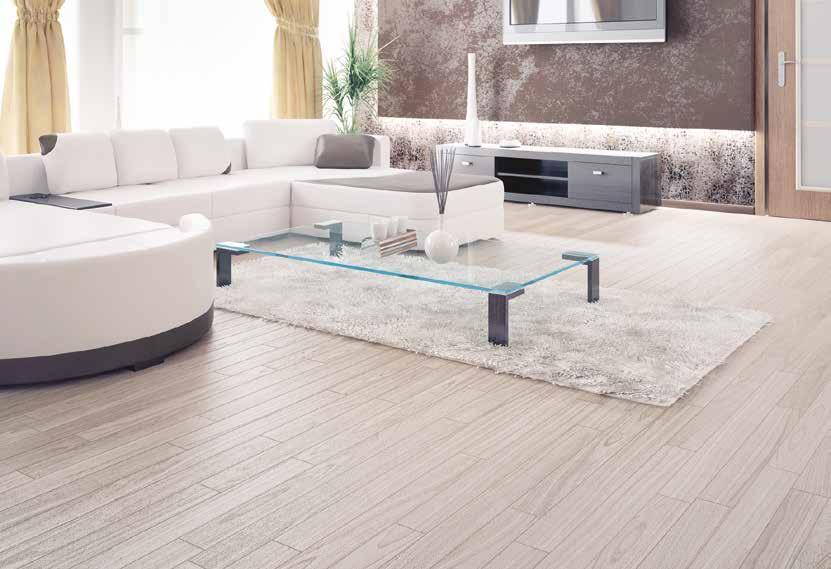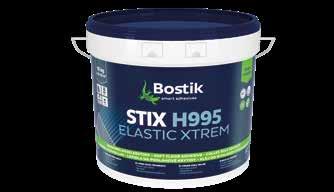
5 minute read
Special Who has silane adhesives for fitting LVT, PVC, vinyl, and design floors?
A ‘SWINGING’ FLOOR?
IF YOU DON’T WANT A TIGHT-FITTING FLOOR, SILANE ADHESIVES ARE IDEAL
Advertisement
Photo – Bona
When it comes to elasticity, more and more professionals are turning to silane adhesives (or MS polymer adhesives or MSP polymer adhesives) for glueing the floor. This adhesive has various assets: It is clean to use, ecological, and, in particular, much more elastic than the average PU adhesive.
If we consider what a silane adhesive actually is, we have to say that it’s a glue which consists of modified silane (SiH4) molecules. The adhesive bonding is created by water (damp in the air) which reacts (polymerises) with the silane compounds. That can be in both one component or two components. If you want a glue with faster bonding, you choose a 2K SMP adhesive. Chemical reactive compounds
What happens during the glueing is that the silane modified polymers consist of chemical reactive compounds which allow the polymer to make an elastic adhesive bonding via contact with humidity. In this way silane glues yield excellent and durable adhesion, yet remain elastic at the same time. That is a huge asset if the flooring still swells and shrinks after the fitting. Moreover, we also see that the adhesives set rapidly so it’s possible to sandpaper the floor and apply a finish barely a day later.
The type which is easiest to use is obviously the mono-component adhesive, which can be deployed for the direct and elastic glueing of
parquet floors consisting of various sorts of wood onto cement-bound or wooden subfloors. With this adhesive it is also possible to glue parquet onto tiles or other non-absorbent, degreased, and soap-free substrates such as, for instance, natural stone or glass. MS polymer adhesives give a permanently elastic adhesion, even when glueing onto floor heating.
Several applications
If we consider what most producers recommend the adhesive for, we notice that they recommend it inter alia for solid wood and wide strips, system floors, anhydrite floors, and sand-cement floors with high residual moisture (up to 4%). However, we also note the warning that you need to take care when fitting a pre-lacquered floor with a damp screen. In that case, you cannot use dispersion adhesives, 1K PU adhesives, or MS polymer adhesives.
No harmful substances
Apart from the elasticity argument, what we particularly like about silane adhesives is that they respect both public health and the environment and they are very convenient to use. It is good to know that these adhesives do not contain any substances which are harmful to human beings or the environment, and that’s obviously good news for both floor fitters during the fitting and end users thereafter. Also not to be underestimated is the fact that you can certainly describe silane adhesives as clean. For instance, you can wash them off your hands easily after use and, if you happen to spill some glue, it’s easy to clean up using water. By way of a drawback it is sometimes said that silane adhesives are rather pricey in use. That’s true if you look solely at the purchase price, but that drawback diminishes completely when you see what you get in return: considerably less glue consumption, excellent adhesive strength, and much faster cleaning than with classic adhesives. And so, are there any drawbacks? We had to search hard to find one, but we did nevertheless discover the following claims: They are less colour-fast and not as resistant to UV rays.
What’s on the market ?
Blanchon

Silane adhesives are highly versatile in use. There is certainly a difference in price, but on the other hand one top quality adhesive will suffice and there are major benefits for parquet floor fitters: resistance against loosening, flexibility, and elasticity. We offer polymer-hybrid adhesives which contain no solvents or isocyanates and respect public health and the environment. AB 2000 and AB 1300 are classified as EC1R (GEV-EMICODE) and optimised packaging. A handy aluminium 6kg bag keeps the waste to a minimum and each supplied box contains two bags. AB 1300 is a highly efficient polymer adhesive for fully glueing large solid parquet floors up to 130mm and up to 260mm with laminated parquet. The adhesive is flexible and elastic and offers strong adhesion on most floors. It is recommended for flexible floors, with a use of 250 to 400 or 500gr/m². AB 2000 is an ultra efficient hybrid polymer adhesive for fully glueing large solid parquet floors up to 200mm and 400mm with laminated parquet. It is suitable for use with floor heating. The adhesive is flexible and elastic, offers excellent adhesion on most floors, and is very easy to apply.
Bona

In 2018, Bona extended its range for the first time with solutions for floor surfaces other than wood, including the Bona Resilient Floor Programme (elastic floors). This programme offers treatments for the renovation of elastic floors. As a further extension, Bona is also planning to develop an adapted silane adhesive within its range. This silane adhesive will relate perfectly to Bona’s existing high-quality and durable assortment of adhesives. The current range includes the fibre-reinforced mono-component dispersion adhesive Bona D750 for glueing PVC design floors in tile or plank format onto absorbent subfloors. Thanks to the high shearing stress resistance, D750 ensures that the emergence of seams is kept to a minimum.
Bostik

Bostik has a ‘silane adhesive’ in its range, namely STIX H995 ELASTIC XTREM. This adhesive will be introduced shortly on the Benelux market. STIX H995 ELASTIC XTREM makes it possible to fit PVC flooring, rubber flooring, and LVT design floors safely. This type of adhesive is used mainly whenever extremely high demands are made of the floor e.g. in damp rooms or floors with high mechanical or thermal stress. STIX H995 ELASTIC XTREM is based on the unique AXIOS TRI-LINKING technology and contains no solvents or phthalates. The fitted floor is ready for use after 24 hours.










